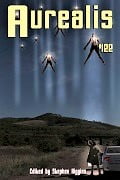“Getting Home” by P K Torrens
Reviewed by Victoria Silverwolf
Three stories set in the depths of space appear in the latest issue of this Australian publication.
“Getting Home” by P K Torrens takes place on an Earth-like world, newly discovered by humans, inhabited by beings that present a mystery. They closely resemble humans in many ways, but have no facial features, are missing many internal organs, and even lack brains. The narrator is a physician who vivisects one of the creatures in search of answers. (The aliens receive a human clone to examine in exchange, an intriguing subplot only briefly mentioned.) The solution leads to a confrontation between the narrator and the military leader of the human expedition.
The explanation for this biological puzzle is interesting, but not always plausible. The antagonist is a caricature, completely evil, foolish, and repulsive. This weakens the story’s believability.
The title character of “Serine” by Shane Drury is the pilot of a small starship. The only other member of the crew is a semi-sentient computer. (The plot turns on the difference between “pseudo” artificial intelligence and true AI. This subtle point is never completely clear.) She arrives at an unexplored planet. A huge space station of unknown origin orbits it. After many adventures, from a battle in space to exploration of the uninhabited, fully automated station, she discovers the truth about the structure, and about her crewmate.
The story moves at a breakneck pace, hardly giving the reader a chance to breathe. The climax is dramatic, but may disappoint readers hoping for a more optimistic ending.
“Tigers of Mars” by Conor DiViesti spends more time inside the narrator’s mind than on the red planet. He is a soldier who did something so terrible that he keeps it hidden from himself. With the help of technology designed to heal his psyche, he creates a virtual world of his own. After learning about a tragic death, which may or may not be real, he attempts to escape from his illusory existence and uncover the facts.
The theme of simulated reality is reminiscent of some of the work of Philip K. Dick, although in a less sophisticated way. The story has strong emotional appeal, even when it is overly confusing.
Victoria Silverwolf recently discovered the existence of ruby chocolate.
 Aurealis #122, July 2019
Aurealis #122, July 2019